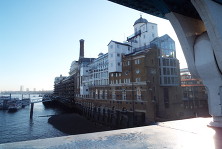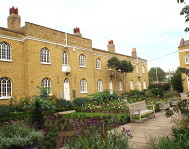








Leysdown Tragedy Memorial, Nunhead Cemetery
There are many poignant memorials and inscriptions in Nunhead Cemetery but the most heart-breaking is the one erected to commemorate the Scouts of the 2nd Walworth Troop drowned off Leysdown, Isle of Sheppey in 1912.
The facts are tragically simple. On 4th August 1912 a cutter left Erith with the tide at 8am. On board were 23 members of the 2nd Walworth Troop of Boy Scouts, escaping for an annual holiday under sail from one of the most deprived and overcrowded areas of London. There were five adults in charge of the party under the leadership of Scout Master Sidney Marsh. Having sailed from Waterloo to Erith the day before, a strong westerly breeze had been blowing most of the day. The cutter had just rounded a point and was two miles out at sea from Leysdown when a strong gust of wind caught the boat and caused it to turn over. Though it quickly righted itself, very soon it capsized again and most of the occupants thrown into the water.
The accident was seen from Leysdown Coastguard Station and a rescue mounted that included a number of swimmers from the Sheppey Boy Scouts. Many of those thrown into the sea were rescued and survived but eight members of the Walworth Boy Scouts and another boy from a training ship perished. All the boys had been properly trained and were experienced, and all were at their posts when the accident happened.
The tragedy moved the nation and Winston Churchill, First Lord of the Admiralty, sent the destroyer Fervent to carry the bodies of the Boy Scouts to London. The coffins, each draped with a Union Jack, were landed at Cherry Garden Pier where scouts were stationed as a guard of honour. There was a procession to St John’s Church, Walworth, described as follows in The Times of 9 August 1912: “In the street there was a large crowd, members of which made no attempt to conceal their sorrow, while in every house for a considerable distance along the route, blinds had been drawn or shutters closed.”
The coffins remained overnight in the church where a vigil was held and many came to pay silent tribute. The first part of the funeral was held at St John’s when the Bishop of Woolwich gave a short address, saying ”The whole of South London has been deeply touched.” The procession to Nunhead Cemetery was a mile long and the streets along the three and a half mile route from the church to the cemetery was densely packed. The crowds were such at the cemetery that a police cordon was needed. The 400 yard path from the cemetery gates to the place of burial was lined by scouts and boys in naval uniform. The Last Post was sounded by half a dozen scout buglars at the end of the burial service.
A monument designed by Sir Giles Gilbert Scott was erected with money donated by the public, the total raised estimated to be £400,000 in today’s money. In 1969, during the time the cemetery was badly neglected and the target of vandalism, the life size bronze scout was stolen and probably sold for scrap. Since then, the cemetery has been renovated and in 1993 the Friends of Nunhead Cemetery arranged for a new memorial to be installed which was donated jointly by a local undertaker and stone mason. There is one name that perhaps the eye of the passer by rests on today, William Beckham. He was the great-great-uncle of David Beckham whose great-grandfather Edward and another great-uncle John were among the rescued.
Web discoveries
- UK Casino Not On Gamstop
- UK Casino Not On Gamstop
- Non Gamstop Casino
- Casinos Not On Gamstop
- Non Gamstop Casinos
- Non Gamstop Casinos
- Non Gamstop Casino
- Casino Sites Not On Gamstop
- Slots Not On Gamstop
- Casinos Not On Gamstop
- UK Betting Sites Not On Gamstop
- UK Casino Not On Gamstop
- Best Non Gamstop Casinos
- Betting Sites
- Non Gamstop Casino Sites UK
- Best Non Gamstop Casinos
- Non Gamstop Casino
- Casinos Not On Gamstop
- Non Gamstop Casino Sites UK